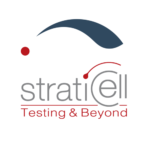Wound-healing In-vitro Efficacy Tests by StratiCELL
18 November 2022
Cutaneous wound healing is a complex physiological process requiring a sequence of molecular and cellular events leading to scar tissue formation. Directly after the skin injury, the haemostasis phase reduces the bleeding, and the inflammatory phase limits the infection. During the subsequent proliferative phase, dermal and epidermal cells highly replicate and migrate to form the epithelial tongue and the granulation tissue. In the final maturation phase, fibroblasts produce extracellular matrix components, as well as matrix metalloproteinases (MMP) favouring the proper remodelling of the dermis.
Several topical treatments have demonstrated their effectiveness to favour those reconstruction processes and avoid poor or impaired wound healing. As a reliable partner in skin testing, StratiCELL evaluates the properties of active ingredients to favour those wound healing phases. Using in vitro cell migration assays, StratiCELL evaluates the re-epithelialization properties of ingredients by measuring their influence on cell proliferation and migration (figure 1).

Figure 1: examples of images from wound healing assay on confluent normal human epidermal keratinocytes, after 0 hour and 24 hours of recolonization.
In addition, specific immunoassays are used to define the dermal remodelling properties of ingredients. Immunofluorescence staining or ELISA assays are validated to detect and quantify a large panel of extra-cellular matrix components like collagen’s, hyaluronic acid or MMP’s (figure 2). Measurement of the enzymatic activity of MMP-1 is also available.

Figure 2 : relative quantification of pro-Collagen-I, Hyaluronan or pro-MMP-1 secreted by normal human dermal fibroblasts after treatment with pro-remodeling factors, in percentage compared to untreated control.
In support to those functional studies or as a screening tool, the impact on the expression of multiple targeted genes is studied by RT-qPCR. To measure and compare the simultaneous expression of multiple genes, StratiCELL uses in routine a microplate-based quantitative PCR system known as “TaqMan Low Density Array” (TLDA). Using this technology, retro-transcripted RNA extracted from treated versus untreated skin cells is loaded into a microfluidic TLDA array designed to amplify 84 genes playing key roles in cell responses to wound healing (figure 3). This powerful transcriptomic tool is therefore an important step in understanding the mechanism of action of innovative compounds restoring injured skins.

Figure 3: representative repartition and biological roles of the 84 genes amplified with the TLDA array related to wound healing properties.
Altogether, this integrated testing strategy is an essential preliminary step to demonstrate and understand the properties of pro-healing dermo-cosmetic compounds.
In order to extend its panel of solutions to investigate scar tissue formation, StratiCELL is currently developing highly relevant 3D wound healing skin models and associated testing assays. Those new tools will be available soon to objectivate the healing properties of innovative compounds. Contact StratiCELL’s team to discuss this interesting topic.
More information: click here
CONTACT
Christel Boudry
Business Developer








 Follow us on Linkedin!
Follow us on Linkedin!
You must be logged in to post a comment.